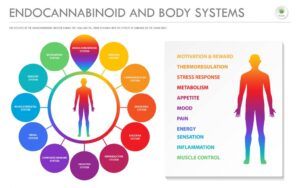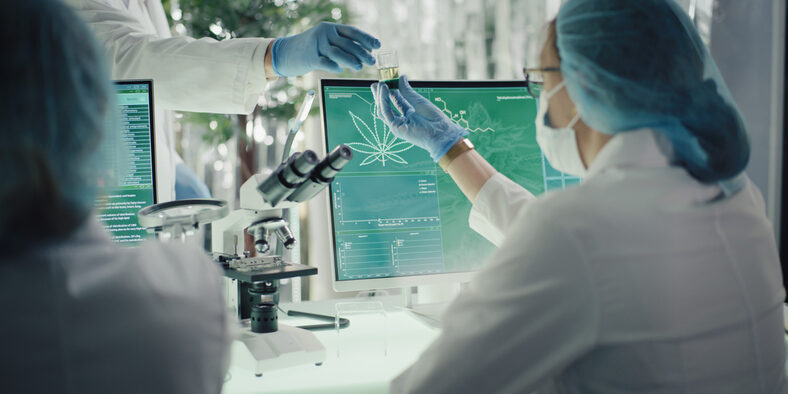Q: What is the endocannabinoid system and what does it do?
I first heard the term endocannabinoid system (ECS) in 2008 from a colleague doing research. It wasn’t something we learned about in medical school and residency training. Even though its discovery was in the late 1980s to early 1990s, many medical schools today do not include the ECS in their curriculums.
According to the Association of American Medical Colleges, only nine percent of medical schools teach anything about the endocannabinoid system and how it relates to medical cannabis science. And about two-thirds of graduates say they feel unprepared to guide and care for medical cannabis patients— and they want and need training.
Our endocannabinoid system (ECS) is ubiquitous throughout the human body. It is a critical neuro-modulating, physiological system that is integral and regulates many of our bodily functions, such as cardiovascular, digestive, endocrine, excretory, nervous, musculoskeletal, reproductive, and immune systems. And it is so ingrained in our evolutionary DNA that all animals, even rudimentary ones such as the sea squirts, have an endocannabinoid system.
The endocannabinoid system is set up to protect us from environmental harms and stressors. The ECS regulates and maintains homeostasis, keeping balance through the body. And we are finding it plays a big role in the disease process and our response to medical cannabis therapy. For example, our ECS has a role in our brain and spinal cord called the central nervous system, affecting our cognition, emotional responses, motor control, and movements.
How does the Endocannabinoid System work?

Endocannabinoid and Body Systems – Endocannabinoid horizontal business infographic illustration about cannabis as herbal alternative medicine and chemical therapy, healthcare and medical science vector.
The ECS is comprised of several types of molecules. The first is our own internal cannabis-like molecules called endocannabinoids (eCB), sometimes referred to as endogenous cannabinoids. Dr. Raphael Mechoulam is known as the father of cannabis research for his discovery and isolation of THC in 1964. It was his lab in 1992 that was the first to isolate the eCB, N-arachidonoylethanolamine, which he named anandamide.
Ananda is the Sanskrit word for bliss. Anandamide is our own internal bliss molecule, whose chemical formula is very similar to THC. Since its discovery, we have identified other endocannabinoid compounds. The second most common and well-known eCB is 2-arachidonoyl glycerol (2-AG).
We have cannabinoid receptors, to which our eCB molecules bind and modulate our physiological systems, such as our nervous system. These receptors were actually discovered first in 1988. They were initially thought of as “orphan receptors.” We did not understand their function until we found the endocannabinoids that interacted with them. There are two types of receptors: CB1 and CB2, which occur in different areas of our body.
CB1 receptors are mostly found in the central nervous system in areas that control pain, nausea, vomiting, emotions, mood, fear, cognition, memory, motor/movement coordination, and our pleasure and reward center. CB2 receptors are found throughout the body and affect our immune, gastrointestinal, reproductive, cardiovascular, peripheral nervous, and other organs and blood cells.
The eCBs are the “keys” that fit into the “locks,” which are the CB1 and CB2 receptors that activate the system during stress, pain, or injury to help regulate our physiological response. Our bodies synthesize them on demand during those times and have special enzymes that break them down when the stress is over.
What is the endocannabinoid system’s role in disease?
As we learn more about the endocannabinoid system, we can begin to understand more about how it may factor into different ailments. For example, in epilepsy and seizure disorders, we can see how our ECS plays a protective role in calming the over-excitation of nerve cells.
During a seizure, there is uncontrolled continuous firing of nerves in our brain that causes convulsion symptoms. Our ECS detects this abnormal function of the nerves and creates the eCB, anandamide, to diffuse in the opposite direction that the nerve impulse is traveling. It then dampens, slows, and stops the over-signaling of the nerve impulse. Once that stress is over and the nerve is calmed, anandamide is broken down by its special enzyme, fatty acid amide hydrolase (FAAH), another critical component in our ECS.
We now know that dysfunction of our ECS or a deficiency of our eCBs could affect the disease state. Famous researcher Dr. Ethan Russo published a paper discussing the theory of Clinical Endocannabinoids Deficiency (CECD). It describes how many medical diseases and conditions that are difficult to treat may, in fact, be due to a dysfunction or deficiency of our ECS. These include migraines, fibromyalgia, irritable bowel syndrome, autism spectrum disorder, and drug-resistant epilepsy.
This notation has been corroborated with research. In a prior Ask Dr. Leigh column on cannabis and seizures, I discussed a 2008 study that found ECS abnormalities related to cannabinoid receptors (CB1) in epileptic brains when compared to normal brain tissue on autopsy. And another study from 2010 found that lower levels of our eCS, anandamide, can be seen in newly diagnosed epilepsy patients.
I also discussed other scientific evidence in one of my articles on cannabis and autism. This study shows how an endocannabinoid deficiency may be associated with autism spectrum disorder. Studies in Israel and the US found children with autism have lower levels of several different endocannabinoids. There is such a correlation that US researchers could possibly use anandamide levels to predict the severity of their autism. The lower the level of anandamide, the more severe patients tend to be on the autism spectrum.
These correlations may explain why many of these medical conditions respond to cannabis therapy. The phytocannabinoids found in the cannabis plant, such as THC and CBD, interact with the cannabinoid receptors in our ECS throughout our body.
The endocannabinoid system: a crucial part of health and wellness
We are continuing to learn more about this critical physiological system that is so integral to our health and well-being. In fact, the runner’s high that people talk about after exercising is not due to endorphins because research has found they do not cross the blood-brain barrier. Instead, it is our own internal central nervous system endocannabinoids that reduce anxiety and cause that good feeling we have after we work out!
Dr. Leigh Vinocur is a board-certified emergency physician who also has a cannabis consulting practice for patients and industry. She is a member of the Society of Cannabis Clinicians and a graduate of the inaugural class, with the first Master of Science in the country in Medical Cannabis Science and Therapeutics from the University of Maryland School of Pharmacy.
Originally published on greenstate.com, April 12, 2023.







